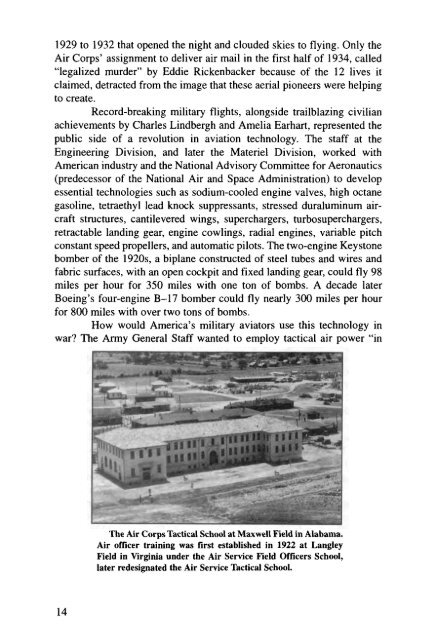A Concise History of the US Air Force - Air Force Historical Studies ...
A Concise History of the US Air Force - Air Force Historical Studies ...
A Concise History of the US Air Force - Air Force Historical Studies ...
Create successful ePaper yourself
Turn your PDF publications into a flip-book with our unique Google optimized e-Paper software.
1929 to 1932 that opened <strong>the</strong> night and clouded skies to flying. Only <strong>the</strong><br />
<strong>Air</strong> Corps’ assignment to deliver air mail in <strong>the</strong> first half <strong>of</strong> 1934, called<br />
“legalized murder” by Eddie Rickenbacker because <strong>of</strong> <strong>the</strong> 12 lives it<br />
claimed, detracted from <strong>the</strong> image that <strong>the</strong>se aerial pioneers were helping<br />
to create.<br />
Record-breaking military flights, alongside trailblazing civilian<br />
achievements by Charles Lindbergh and Amelia Earhart, represented <strong>the</strong><br />
public side <strong>of</strong> a revolution in aviation technology. The staff at <strong>the</strong><br />
Engineering Division, and later <strong>the</strong> Materiel Division, worked with<br />
American industry and <strong>the</strong> National Advisory Committee for Aeronautics<br />
(predecessor <strong>of</strong> <strong>the</strong> National <strong>Air</strong> and Space Administration) to develop<br />
essential technologies such as sodium-cooled engine valves, high octane<br />
gasoline, tetraethyl lead knock suppressants, stressed duraluminum air-<br />
craft structures, cantilevered wings, superchargers, turbosuperchargers,<br />
retractable landing gear, engine cowlings, radial engines, variable pitch<br />
constant speed propellers, and automatic pilots. The two-engine Keystone<br />
bomber <strong>of</strong> <strong>the</strong> 1920s, a biplane constructed <strong>of</strong> steel tubes and wires and<br />
fabric surfaces, with an open cockpit and fixed landing gear, could fly 98<br />
miles per hour for 350 miles with one ton <strong>of</strong> bombs. A decade later<br />
Boeing’s four-engine B-17 bomber could fly nearly 300 miles per hour<br />
for 800 miles with over two tons <strong>of</strong> bombs.<br />
How would America’s military aviators use this technology in<br />
war? The Army General Staff wanted to employ tactical air power “in<br />
14<br />
The <strong>Air</strong> Corps Tactical School at Maxwell Field in Alabama.<br />
<strong>Air</strong> <strong>of</strong>ficer training was first established in 1922 at Langley<br />
Field in Virginia under <strong>the</strong> <strong>Air</strong> Service Field Officers School,<br />
later redesignated <strong>the</strong> <strong>Air</strong> Service Tactical School.
















